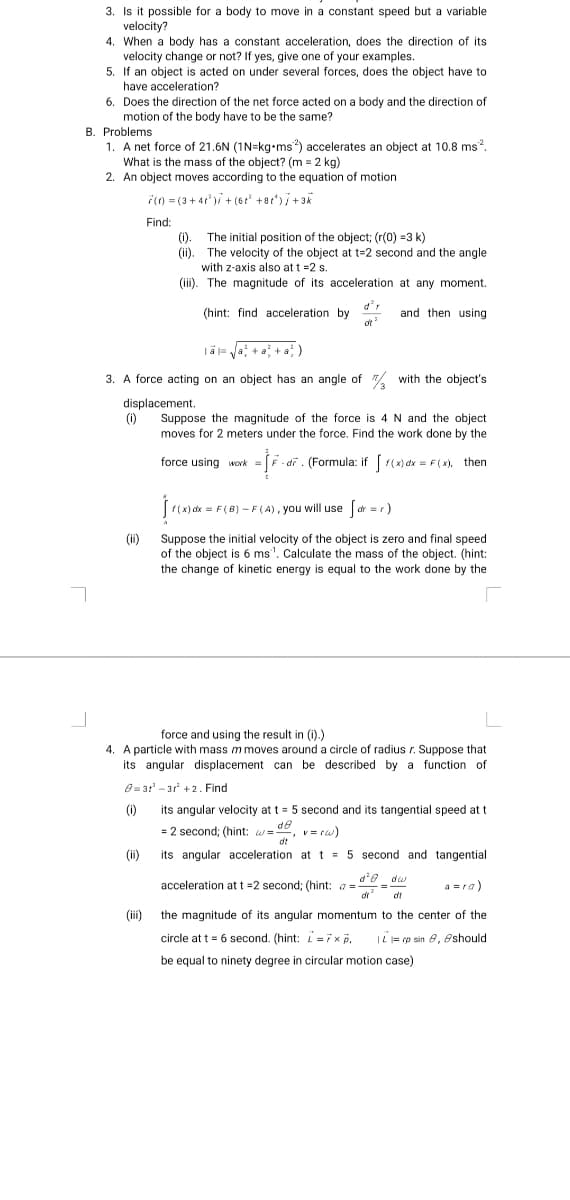Physics for Scientists and Engineers
10th Edition
ISBN:9781337553278
Author:Raymond A. Serway, John W. Jewett
Publisher:Raymond A. Serway, John W. Jewett
Chapter6: Circular Motion And Other Applications Of Newton's Laws
Section: Chapter Questions
Problem 14P: An object of mass m = 5.00 kg, attached to a spring scale, rests on a frictionless, horizontal...
Related questions
Topic Video
Question

Transcribed Image Text:3. Is it possible for a body to move in a constant speed but a variable
velocity?
4. When a body has a constant acceleration, does the direction of its
velocity change or not? If yes, give one of your examples.
5. If an object is acted on under several forces, does the object have to
have acceleration?
6. Does the direction of the net force acted on a body and the direction of
motion of the body have to be the same?
B. Problems
1. A net force of 21.6N (1N=kg•ms?) accelerates an object at 10.8 ms?.
What is the mass of the object? (m = 2 kg)
2. An object moves according to the equation of motion
7() = (3+ 41')i + (6e +8r')+3k
Find:
(i). The initial position of the object; (r(0) =3 k)
(ii). The velocity of the object at t=2 second and the angle
with z-axis also at t =2 s.
(ii). The magnitude of its acceleration at any moment.
(hint: find acceleration by
dt
and then using
3. A force acting on an object has an angle of % with the object's
displacement.
(i)
Suppose the magnitude of the force is 4 N and the object
moves for 2 meters under the force. Find the work done by the
force using work = [F- di . (Formula: if [ (x) dx = F(x). then
[((x) dx = F(8) – F(A) , you will use [dr = r)
(ii)
Suppose the initial velocity of the object is zero and final speed
of the object is 6 ms'. Calculate the mass of the object. (hint:
the change of kinetic energy is equal to the work done by the
force and using the result in (i).)
4. A particle with mass m moves around a circle of radius r. Suppose that
its angular displacement can be described by a function of
8= 31 - 31 +2. Find
(1)
its angular velocity at t = 5 second and its tangential speed at t
= 2 second; (hint: w =-
, v = ra)
(ii)
its angular acceleration at t = 5 second and tangential
d'0 dw
acceleration at t =2 second; (hint: a =
a = ra)
di
dt
(ii)
the magnitude of its angular momentum to the center of the
circle at t = 6 second. (hint: i= i x ë,
IL= rp sin 8, eshould
be equal to ninety degree in circular motion case)
Expert Solution
This question has been solved!
Explore an expertly crafted, step-by-step solution for a thorough understanding of key concepts.
Step by step
Solved in 2 steps

Knowledge Booster
Learn more about
Need a deep-dive on the concept behind this application? Look no further. Learn more about this topic, physics and related others by exploring similar questions and additional content below.Recommended textbooks for you

Physics for Scientists and Engineers
Physics
ISBN:
9781337553278
Author:
Raymond A. Serway, John W. Jewett
Publisher:
Cengage Learning

Physics for Scientists and Engineers with Modern …
Physics
ISBN:
9781337553292
Author:
Raymond A. Serway, John W. Jewett
Publisher:
Cengage Learning


Physics for Scientists and Engineers
Physics
ISBN:
9781337553278
Author:
Raymond A. Serway, John W. Jewett
Publisher:
Cengage Learning

Physics for Scientists and Engineers with Modern …
Physics
ISBN:
9781337553292
Author:
Raymond A. Serway, John W. Jewett
Publisher:
Cengage Learning


Physics for Scientists and Engineers: Foundations…
Physics
ISBN:
9781133939146
Author:
Katz, Debora M.
Publisher:
Cengage Learning

College Physics
Physics
ISBN:
9781285737027
Author:
Raymond A. Serway, Chris Vuille
Publisher:
Cengage Learning

College Physics
Physics
ISBN:
9781305952300
Author:
Raymond A. Serway, Chris Vuille
Publisher:
Cengage Learning